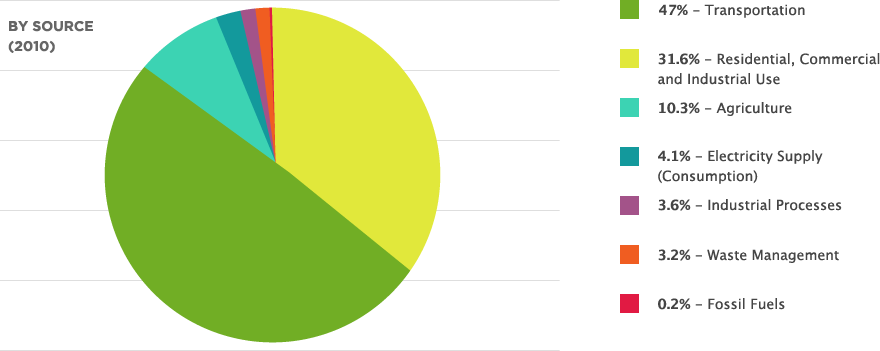Comprehensive Energy Plan
The Vermont Comprehensive Energy Plan (CEP) is prepared by the Public Service Department to address Vermont’s energy future across all sectors, including transportation. The current CEP calls for much higher use of renewable energy over the next 35 years and electric vehicles are one way to help the state shift from non-renewable petroleum fuels to cleaner sources of energy.
Vermont Greenhouse Gas Emissions

Transforming Vermont Transportation
The State of Vermont’s Comprehensive Energy Plan (CEP) addresses Vermont’s energy future for electricity, building heating, industrial processing, transportation, and land use. The 2016 CEP sets specific goals and strategies for Vermont to obtain 90% of our total energy from renewable sources by 2050.
Vermont’s transportation sector is currently fueled 94% by petroleum. To transform the transportation sector, the 2016 CEP identifies four primary strategies:
 Efficient Land Use
Efficient Land Use
Vermont’s land use goals call for maintaining historical settlement patterns of compact centers surrounded by rural countryside to provide walkable, transit friendly environments that require less automobile use.
 Shift Single Occupant Vehicles
Shift Single Occupant Vehicles
Increase the availability of transportation choices (such as carpooling, public transit, walking, biking) to provide safe and economical options to travel in single occupant vehicles.
 Electrify Light Duty Vehicles
Electrify Light Duty Vehicles
The CEP sets a goal of powering 10% of Vermont vehicles by electricity in 2025. Electric cars are much more efficient than gasoline powered vehicles and can be readily powered by renewable sources of electricity. This strategy also includes increasing the overall efficiency of fossil fueled light duty vehicles.
 Heavy Duty Vehicle Efficiency
Heavy Duty Vehicle Efficiency
Increase the efficiency of heavy-duty vehicles and power them with renewable fuels, such as advanced liquid or gaseous biofuels. Expanded fueling infrastructure and increasing fuel availability.
Electric Vehicle Technology in Vermont
Electric vehicle technology is of particular interest to Vermont. Nearly half of Vermont’s electricity already comes from renewable sources and this continues to increase. Deploying electric vehicles to take advantage of this clean energy will help Vermont reach our 90% renewable goal. And, there are other important benefits to switching from conventional gas and diesel powered vehicles to electric vehicles:
- Electric rates in Vermont have been relatively stable for 20 years, whereas prices for petroleum-based fuels are extremely volatile.
- In response to stepped-up vehicle efficiency standards, the global auto industry has identified electric vehicles as a primary market trend.
- All major auto manufacturers have released or announced electric vehicle models to be available in the next few years, including more affordable models with electric range over 200 miles. Vermont will be poised to accommodate all who choose to drive electric vehicles, including Vermonters, visitors, and other drivers passing through our state.
- Most of the cost of charging electric vehicles stays in Vermont. Rather than sending gasoline dollars out of state, and out of the region, electric powered vehicles keep more revenues in-state, contributing to energy independence for Vermont, and supporting Vermont’s economy.
- Vermont’s electricity supply is one of the cleanest in the nation. Our electric sector is responsible for about 12% of statewide greenhouse gas emissions and is increasingly renewable. Conversely, Vermont’s petroleum fueled transportation sector emits 47% of Vermont’s total greenhouse gases.
- Automakers are investing heavily in electric vehicle applications of autonomous vehicle technologies, which may further increase travel efficiency and convenience through connected car systems.
Summarizing Statements from Vermont's 2016 CEP
“achieving significant reductions of GHG emissions and fossil fuel consumption in Vermont’s transportation sector will require a large-scale transformation to alternatively fueled vehicles that reduce petroleum usage and related emissions with advanced technologies and fuels (such as plug-in hybrid electric vehicles, all-electric vehicles, and fuel-cell electric vehicles). Indeed, Vermont’s 2011 CEP identified vehicle electrification as a primary pathway to enable the state to meet its renewable energy goal, and set an objective to have 25% of vehicles registered in the state powered by renewable sources by 2030."
(2016 CEP, Chapter 8, page 158)
"Widespread adoption of electric vehicles in Vermont will advance multiple state priorities: protecting public health and the environment by reducing transportation-related air pollution and GHG emissions, enhancing energy diversity, saving consumers money, and promoting economic growth."
(2016 CEP, Chapter 8, page 158)
For more information
2016 Vermont Comprehensive Energy Plan http://publicservice.vermont.gov/publications-resources/publications/energy_plan/2015_plan
US Department of Energy http://www.afdc.energy.gov/fuels/electricity_benefits.html